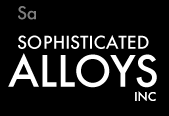Our Formula for a “No Surprise” Custom Alloys Quote
In the specialty alloys business, as with other businesses, a potential customer will always ask: “How much will it cost?” and “When can I have it?” We understand the constraints of working within a budget and meeting production deadlines, so we know why these two questions are so important. But unlike some other businesses, everything is made to order here. We don’t open up a catalog and check a price. That’s why people are sometimes surprised to learn the many other important questions that must be asked before a quote or a more detailed statement of work can be provided.
Before we deliver your quote or statement of work, here are some things we need to consider about your alloy:
What are the specifications?
Larger companies often come to us with detailed specifications for everything from the alloy composition with tolerances on major and trace elements to detailed process parameters. This helps a lot in ensuring that they get exactly what they want, but it also helps us to give them an accurate quote or statement of work. Potential customers from smaller companies often don’t provide that level of detail or don’t even realize that their simple request isn’t quite as simple as it sounds. Misunderstandings can be avoided if we talk early in the process, even when you think you know exactly what you want.
How much material do we need to pour?
A potential customer may think this is an easy one. When he says: “Quote me a price of ‘X’ amount of alloy”, he may think that’s exactly what we pour. He may not consider factors such as shrinkage and scrap loss from post-melt processes. The trick is to pour just enough: just enough that we get what you need and just enough that our price is still right and we haven’t generated a lot of scrap in the process. We have lots of experience with the sorts of calculations required to determine the quantity to pour, and our quote will always reflect these considerations.
What is the final form?
One of the first considerations when we think about your final product is mold selection. Choose the wrong mold and you are on the wrong path from the start. Choose one too large and you’re going to be paying for a lot of scrap. Choose one too small and your product may not clean up. We have a wide selection of molds that we can suggest, but we can also fabricate a custom mold to meet your requirements if we don’t have the one needed for your alloy.
In discussing the final form of your alloy it is important to consider the methods that can be used in making the finished product. We have wide range of experience with cutting alloys that accomplishes two goals: keep scrap to a minimum and keep costs down. Depending on the alloy, we may choose conventional machining or EDM or we may choose to grind, turn or mill the alloy. Choosing the wrong method for a particular alloy can be expensive or, worse, sometimes it can be disastrous.
What are the possible melt interactions that might occur?
Failing to anticipate possible melt interactions can adversely affect your final product. Over the years we have learned what to expect when making various alloys as well as how to offset adverse reactions and still achieve the right chemical composition. Among other considerations, the boiling point of the constituents must be considered as well as how to prevent evaporation of melt components. There are many ways to account for possible reactions that may occur. It might be something as simple as loading the alloy components into the crucible in a particular order. Or we may have to pre-alloy some melt components or make tweaks to the melt additions. Whatever the situation, we are always mindful of melt interactions at the time a quote is developed so that unhappy surprises can be avoided.
Will post-melt processing be needed?
Regardless of whether we will do post-melt processing on your material or if you will have it done elsewhere, we always work backward from what your finished product will look like. This enables us to quote the right amount of alloy to get your finished product and to ensure that it will perform the way you intend it to.
If we will be handling the post-melt processing, we need to clearly define the parameters. For example, if your product will be rolled, we need to agree on a rolling temperature, the number of reductions per pass, the percentage of reduction per pass, etc. All of these things will be spelled out in our quote.
As we work on your quote we focus on your satisfaction with the end product. For example, you might not have considered HIPing (Hot Isostatic Pressing) your alloy to achieve sound material, but we have. This extra step adds to your cost, but it is better to know in advance how best to achieve the alloy you need.
There’s a lot of complex problem solving involved in providing you the answer to your questions of “how much will it cost?” and “when can I have it?”. Of course we draw on our experience and technical skills to come up with solutions, and we pride ourselves on thinking through every little detail. It’s the best way to make sure we provide complete customer satisfaction and avoid some ugly surprises.


